One of the most common questions I get asked by cheese lovers is “can you eat cheese rinds?”. To answer this question, let’s start by having a look at the different types of cheese rinds. And then we’ll guide you through which cheese rinds are edible with 23 very popular examples from around the world.

SEE ALSO: What do you call the different parts of cheese? →
What is cheese rind?
In simple terms, the rind is the outside of the cheese. But there are many different types of cheese rinds. Overall, the rind plays an important role in both protecting the inside of the cheese and also texture and flavour development as it matures.
Different types of rind
Natural
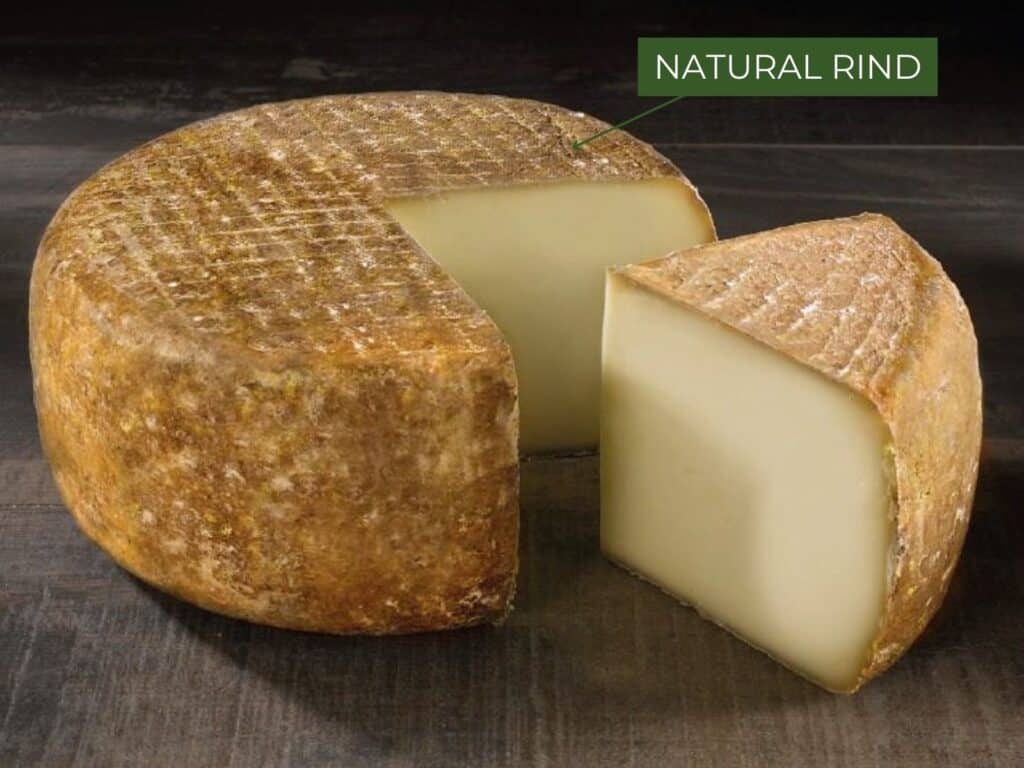
Unsurprisingly, a natural rind is one that forms naturally around the cheese as it ages. As a matter of fact, you can find natural rinds on a number of different types of cheeses. Some popular examples are soft white mould cheeses like Brie and Camembert. And soft washed rind cheeses like Epoisses, Langres and Taleggio.
In all of those examples, the rind assists in proteolysis (the breakdown of milk proteins) to create the texture of the cheese. Because of this, we refer to such cheeses as surface-ripened cheeses.
Having said this, soft cheeses aren’t the only type that can form a natural rind. Pressed cheeses such as Cheddar and Parmigiano Reggiano develop a natural rind as they mature.
Moreover, washed rind pressed cheeses like Gruyère, Comté and Raclette develop a natural rind that is influenced by the brine (salt water) solution that cheesemakers wash them in. The brining favours the growth of specific bacteria on the surface of the cheese which produce a sticky brown/orange rind.
Clothbound
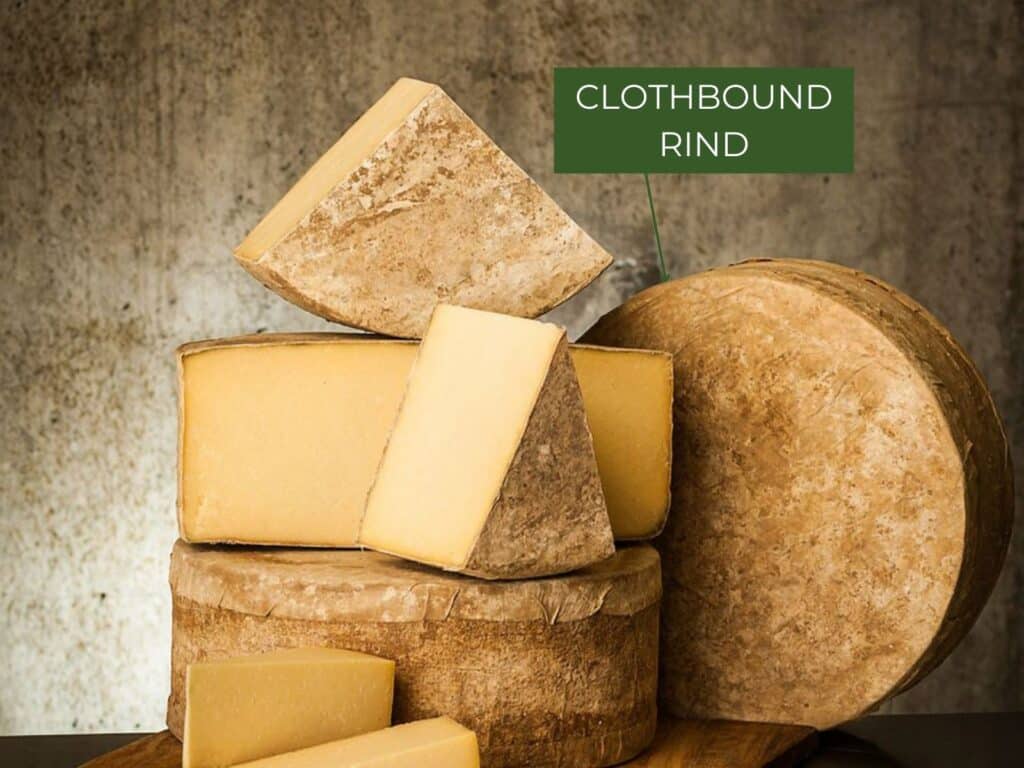
The remaining types of rind we’ll be looking at are created by human intervention. The first one is the traditional practice of wrapping Cheddars in cloth. Actually, this practice originates either in England or the USA (depending on who you ask) and forms a breathable barrier around the cheese.
As the Cheddar matures, it develops unique aromas and flavours that can be credited to the lard they’re coated in and the cloth that they’re wrapped in. Of course, this type of rind is not edible and you should remove it before you eat the cheese.
Wax
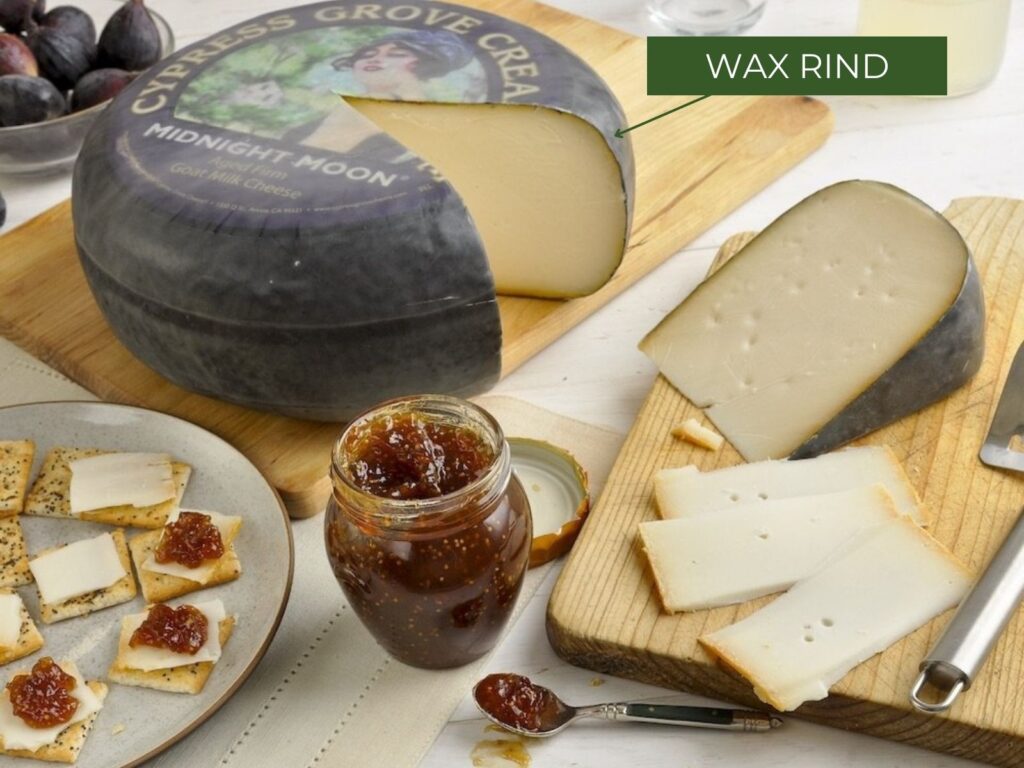
Finally, we have wax rinds. This particular type of rind is formed by applying a melted wax mixture to the outside of the cheese as soon as it is made. As the wax cools down, it forms a protective layer around the cheese.
This practice is very common with Dutch cheeses like Gouda and Edam. But you can also find wax rinds on certain Cheddars and blue cheeses.
The main benefits of coating a cheese in wax is to protect it from external elements and trap more moisture inside. Hence, you will often find that a waxed Cheddar will be softer and less crumbly than a clothbound one.
Which cheeses have an edible rind?
The best way to answer this question is to have a look at some of the most popular cheeses around the world. For each cheese, we will give you a little bit of background and describe the rind. And, of course, we will let you know whether you can eat the rind or not.
Disclaimer
All of our edible rind recommendations do not take into account pregnancy, lactose intolerance and milk protein intolerance. You can read more on our recommendations for those conditions by clicking on each individual one.
Brie
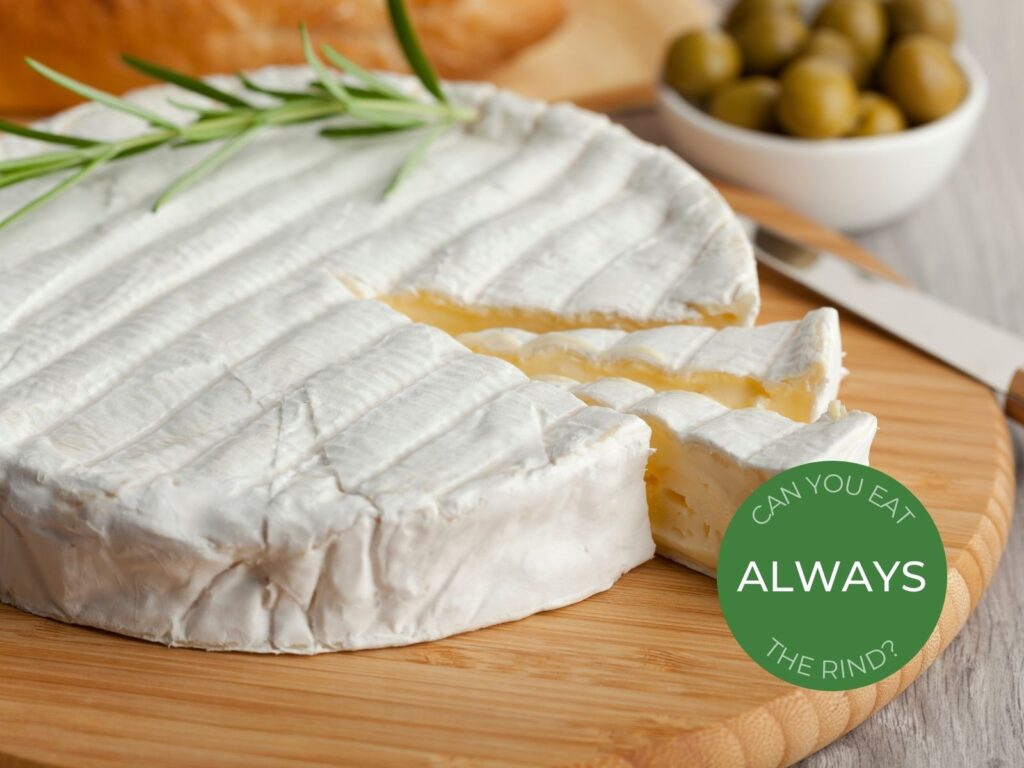
Without a doubt, Brie is one of the most popular soft cheeses from anywhere in the world. This soft white mould cheese from Ile-de-France has a bloomy natural rind consisting largely of Penicillium candidum.
And, yes, you can most definitely eat this rind. As a matter of fact, I would urge you to because some of the most intense and beautiful flavours from Brie will be found on the rind. Look out for earthy and mushroom notes with the most subtle of crunches.
Brillat-Savarin
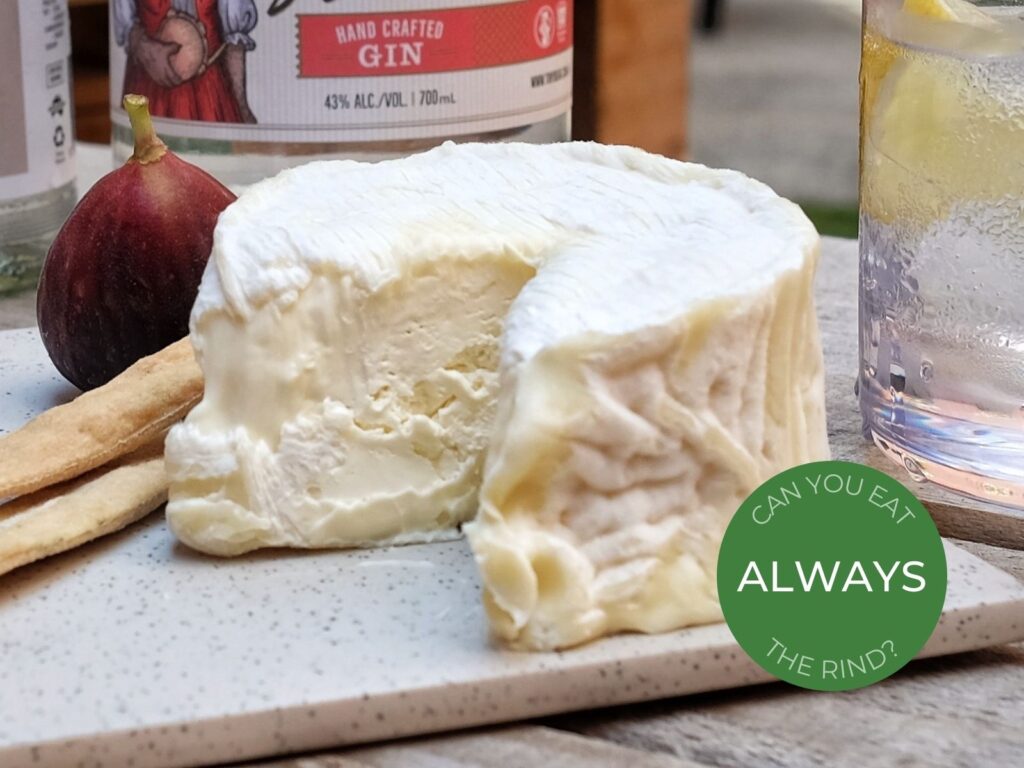
Brillat-Savarin is a decadent triple cream cheese that originates from the Bourgogne region of France. Once again, this is an example of a soft white mould cheese consisting of both Penicillium camemberti and Geotrichum candidum.
As was the case with Brie, the natural rind on Brillat-Savarin is not only edible, it is delicious!
Camembert
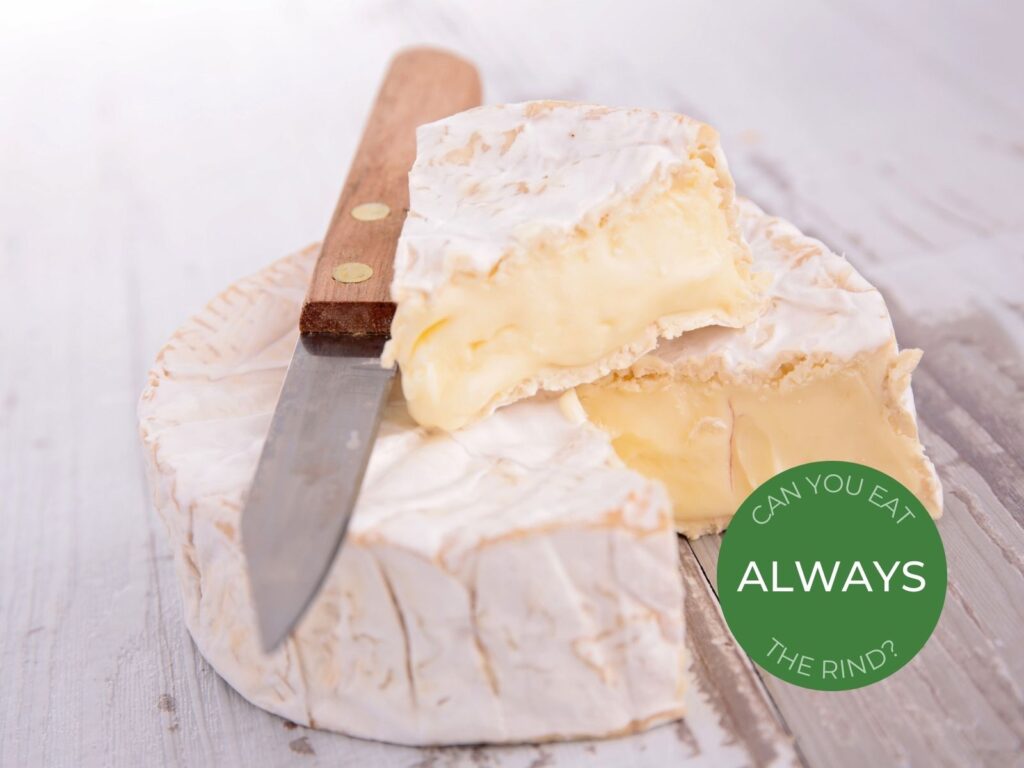
The final soft white mould cow’s milk cheese on our list is Camembert. Undoubtedly, Camembert is just as famous as Brie. And its natural rind is also made up of Penicillium candidum.
Of course, you can eat this beautiful rind. And I’d go as far as to say that you should eat it. Watch out for even more intense flavours of mushroom and forest floor than with Brie.
Clothbound Cheddar
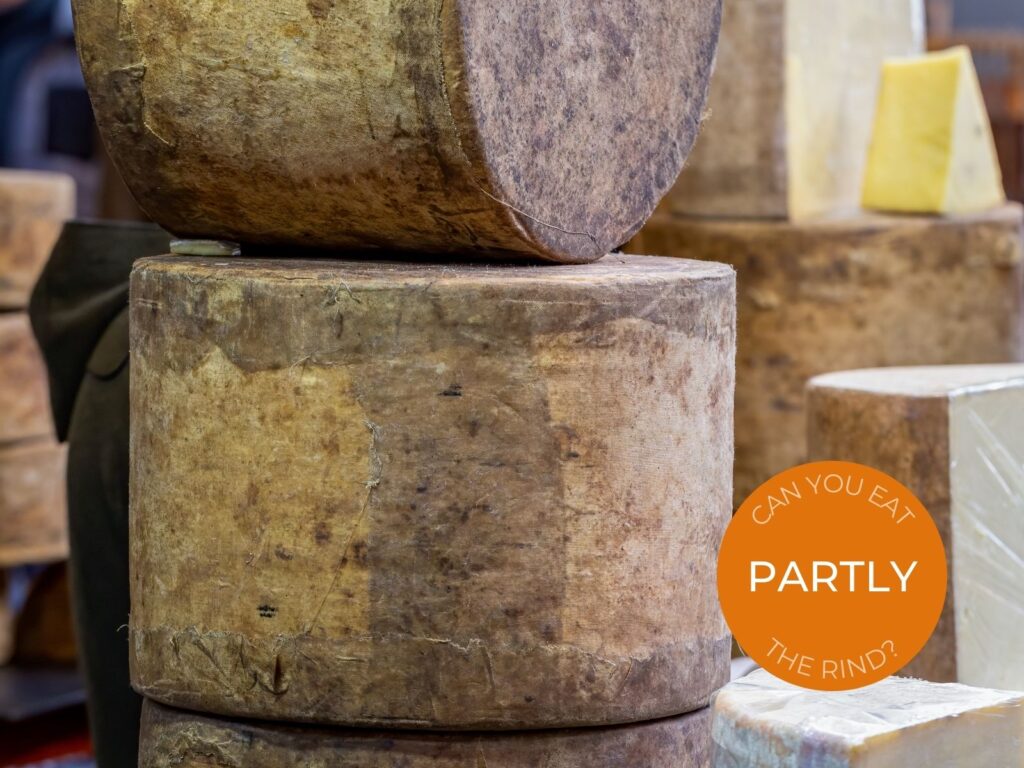
Next, we have the world’s most popular cheese, Cheddar. For the purpose of this exercise, we’re looking at a very specific type of Cheddar, Clothbound Cheddar. As we mentioned earlier, some traditional Cheddars from the UK and the USA are wrapped in cloth before maturation.
And mark my words when I say that you do not want to eat this cloth!
Having said that, we’ve categorised Cheddar under “Partly” because you can still eat the rind that is under the cloth. In fact, you will get a beautiful earthy flavour from this part of the cheese. And, of course, you can eat the rind of any Cheddar that has not been wrapped in cloth or coated in wax.
Comté
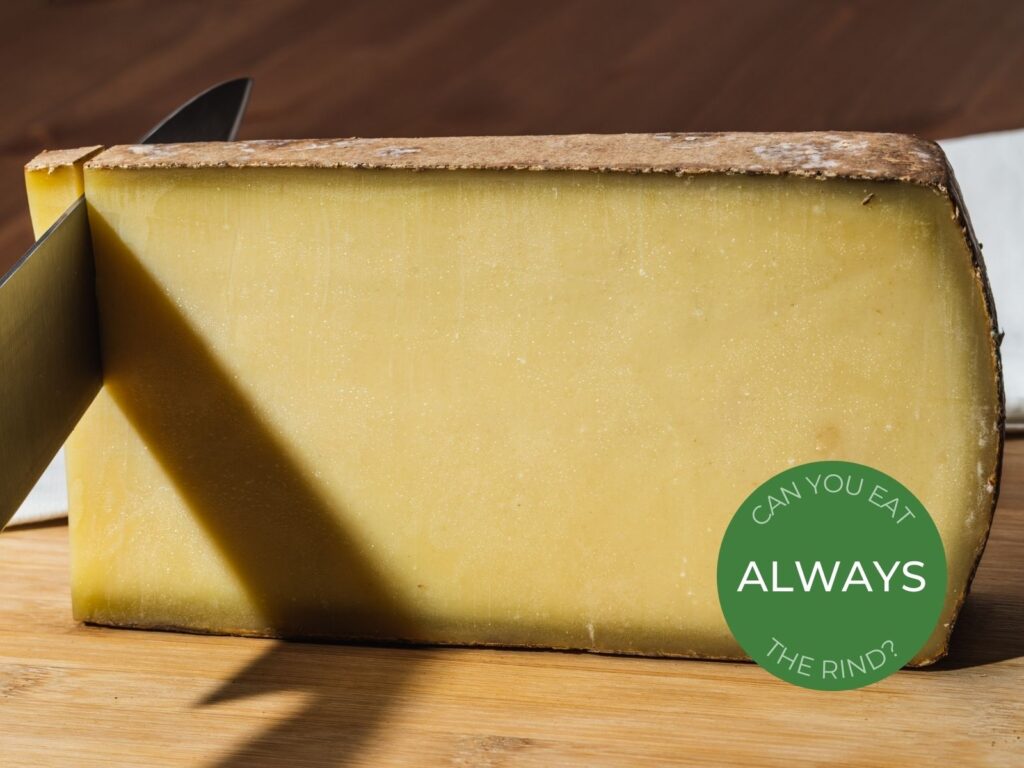
Comté is a pressed cooked raw milk cheese that originates from the Jura mountains in France. As a matter of fact, this traditional mountain cheese is one of France’s most popular AOP cheeses.
During maturation in high altitudes caves, Comté develops a rustic rust-coloured rind. And, this rind is not only edible, it is spectacular! Look out for tantalising nutty and fruity flavours.
Epoisses
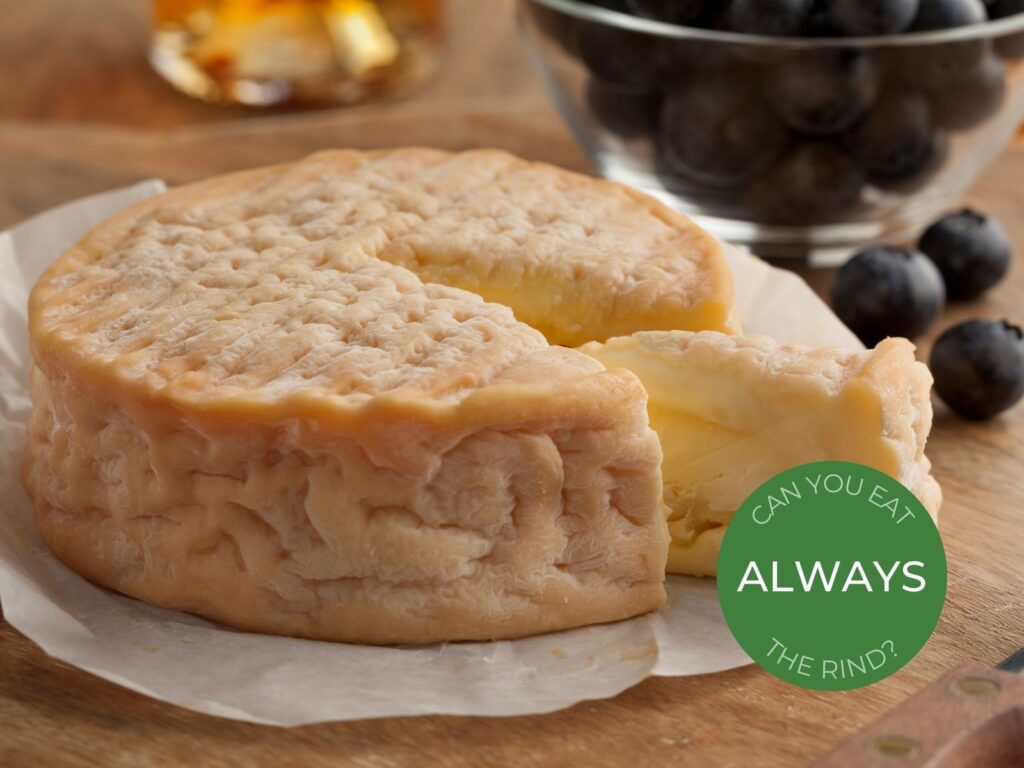
We were going to have to talk about washed rind cheeses at some point! So, let’s start with France’s most famous (or is it infamous?) washed rind, Epoisses de Bourgogne. This monastic cow’s milk cheese is washed with Marc de Bourgogne during maturation to produce a sticky, pungent, brick red rind.
And you can definitely eat its rind. A word of warning though, some people find it a bit too strong. Brace yourself for a robust brothy and meaty flavour.
Gorgonzola
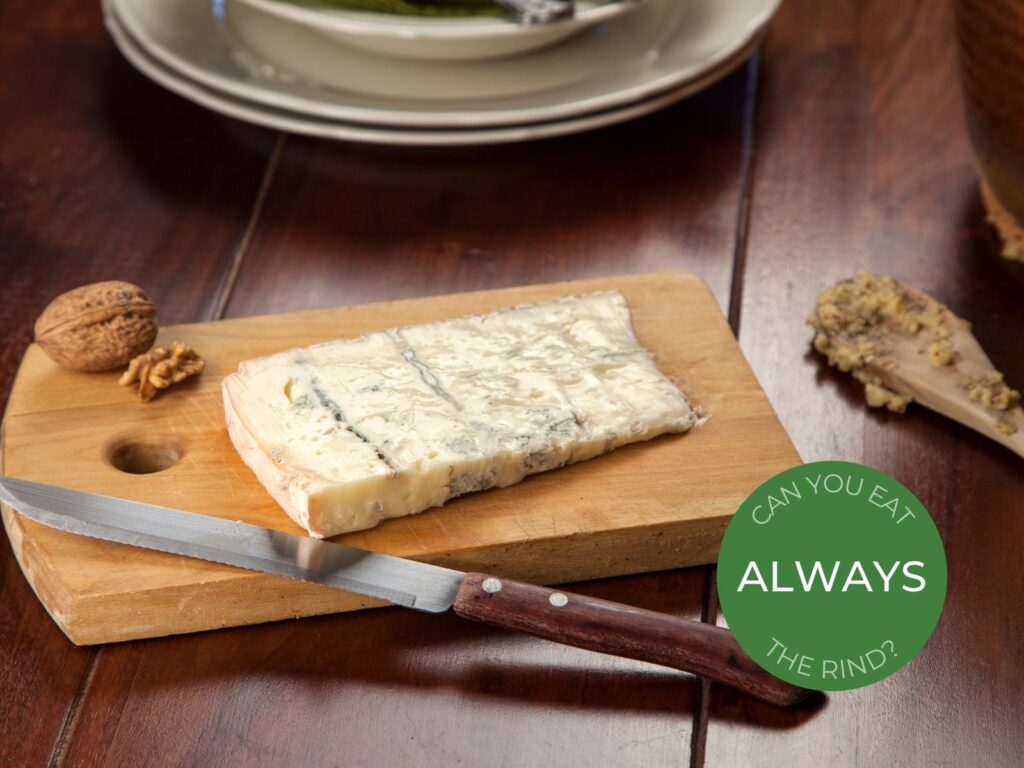
Northen Italy’s Gorgonzola is one of the world’s most famous blue cheeses. In most countries, you will be able to buy two types of Gorgonzola: Dolce and Piccante. And all forms of this cow’s milk blue cheese usually come wrapped in foil.
Once you’ve removed the foil, you will uncover a beautiful natural rind. While it does not have the intense flavour that some of the rinds above do, Gorgonzola’s rind is still very much safe and fun to eat.
Gouda
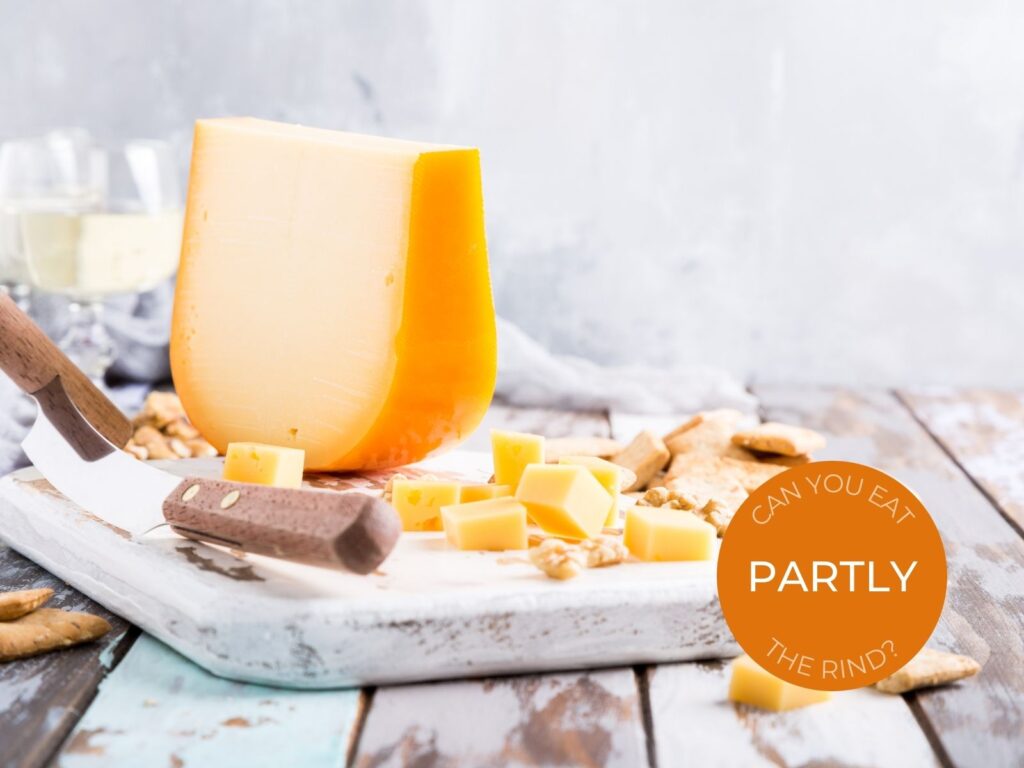
Let’s take a little detour via the Netherlands to talk about their most famous cheese, Gouda. This pressed uncooked cheese finds its roots in South Holland and is traditionally wrapped in wax. As was the case with Clothbound Cheddar, we have classified Gouda as “Partly”.
While you definitely do not want to eat the wax rind, you can peel this layer off to reveal another rind. This hardened layer of cheese is actually edible, but its texture can make it quite hard to eat at times.
Grana Padano
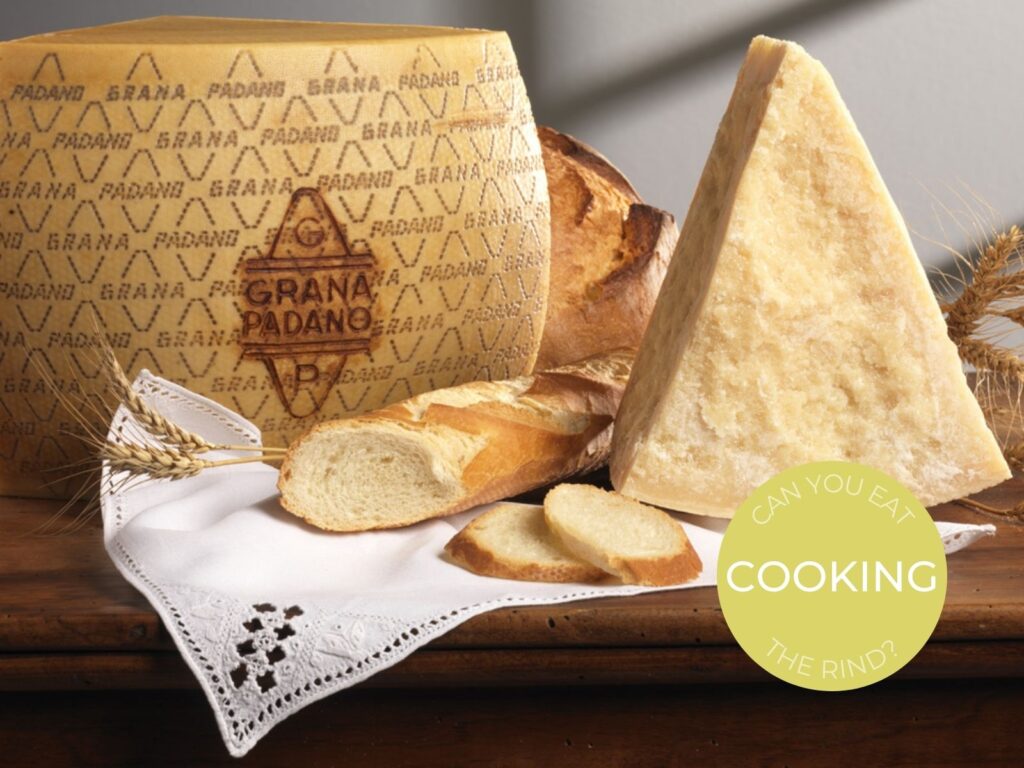
Grana Padano is a grossly underrated pressed cooked cheese that comes from the Po River Valley in northern Italy. It is often mistaken for another cheese from the region that is much more famous. But we will get to that one a little bit later.
During maturation, wheels of Grana Padano form a thick natural rind that will probably break your teeth if you try to eat it. But that does not mean that you have to discard it. Indeed, Grana Padano rind is a great addition to vegetable stock or pasta sauce because it is packed with a lot of the flavours found in the cheese.
Gruyère
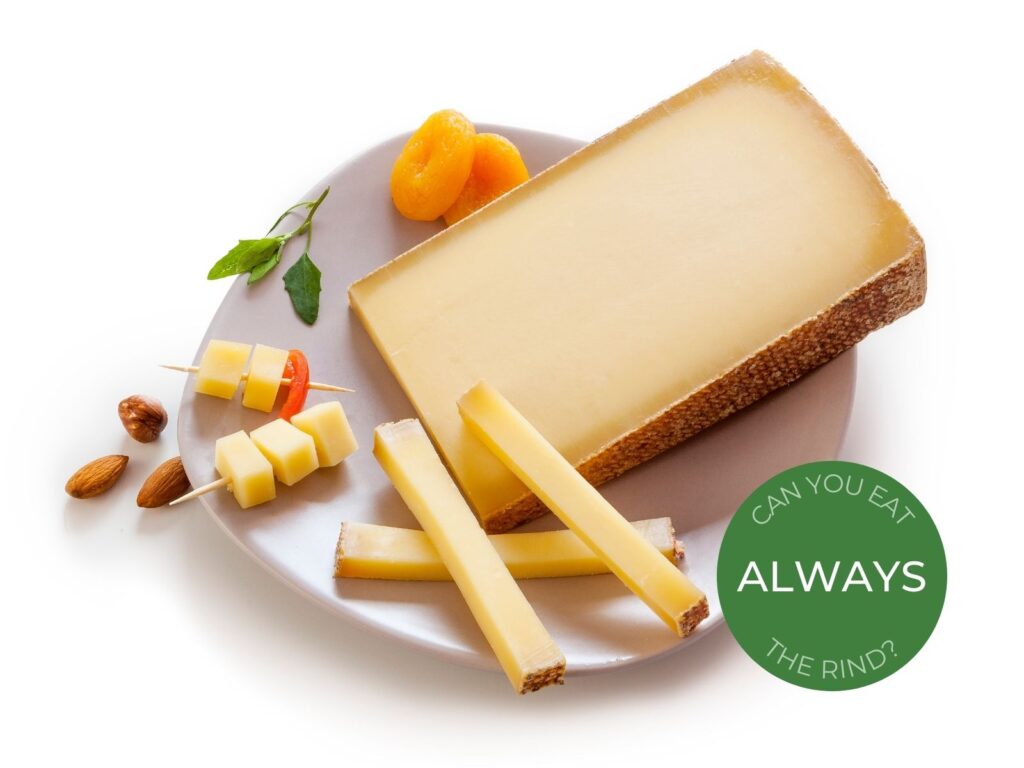
Switzerland’s most famous cheese would have to be Gruyère. This traditional raw cow’s milk cheese finds its roots in the Swiss Alps and is matured at altitude. Similar to Comté, large wheels of Gruyère age at altitude and form a rustic natural rind.
Actually, some of the best flavours (sweet, grassy and nutty) of this cheese will be round in its edible rind. So, you want to make sure that you give it a try.
You can read more about Gruyère’s rind in our comprehensive post here.
Mahón
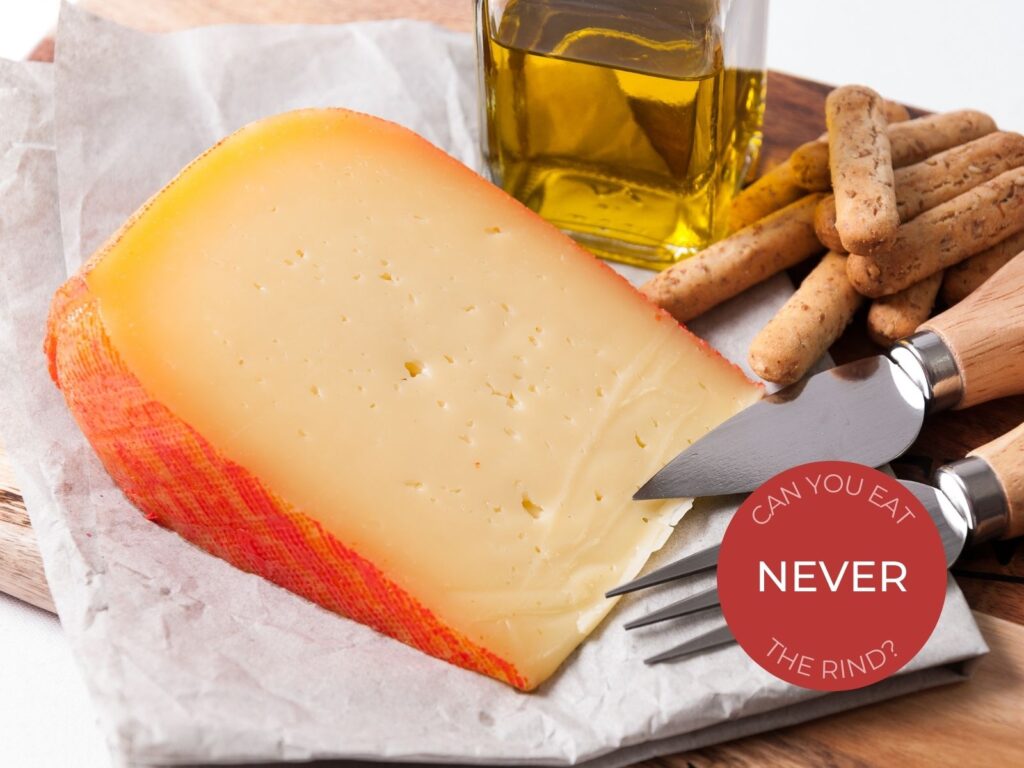
Mahón is the first of two Spanish cheeses that we will be talking about. This traditional cow’s milk cheese comes from the Mediterranean island of Menorca. And most wheels of Mahón (artisanal and commercial) are rubbed in a mixture containing olive oil during ageing.
As a result, the cheese forms a hard, almost waxy rind that should not be eaten.
Manchego
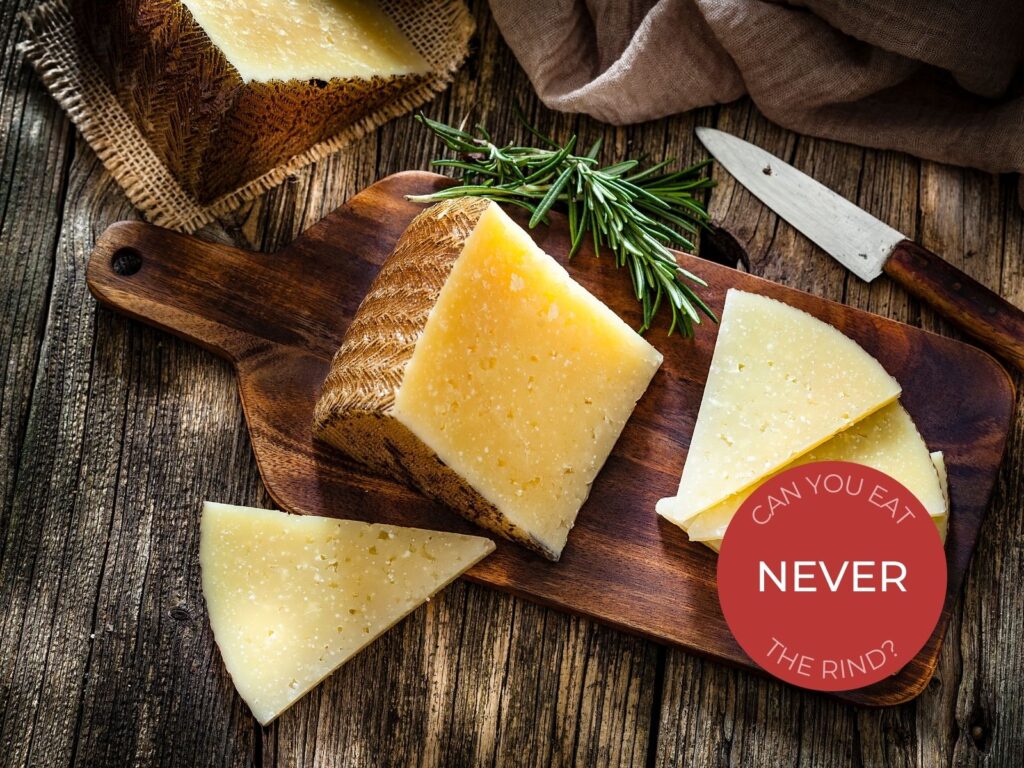
By far, Manchego is Spain’s most famous and popular cheese. This sheep’s milk cheese from La Mancha is made in iconic moulds that have a herringbone texture on them. As the cheese matures, it is also rubbed in an olive oil mixture to form a hard rind.
Moreover, a number of commercial Manchego produces also add a wax layer to the outside of their cheese. For that reason, you will probably not want to eat the rind of this cheese.
Mimolette
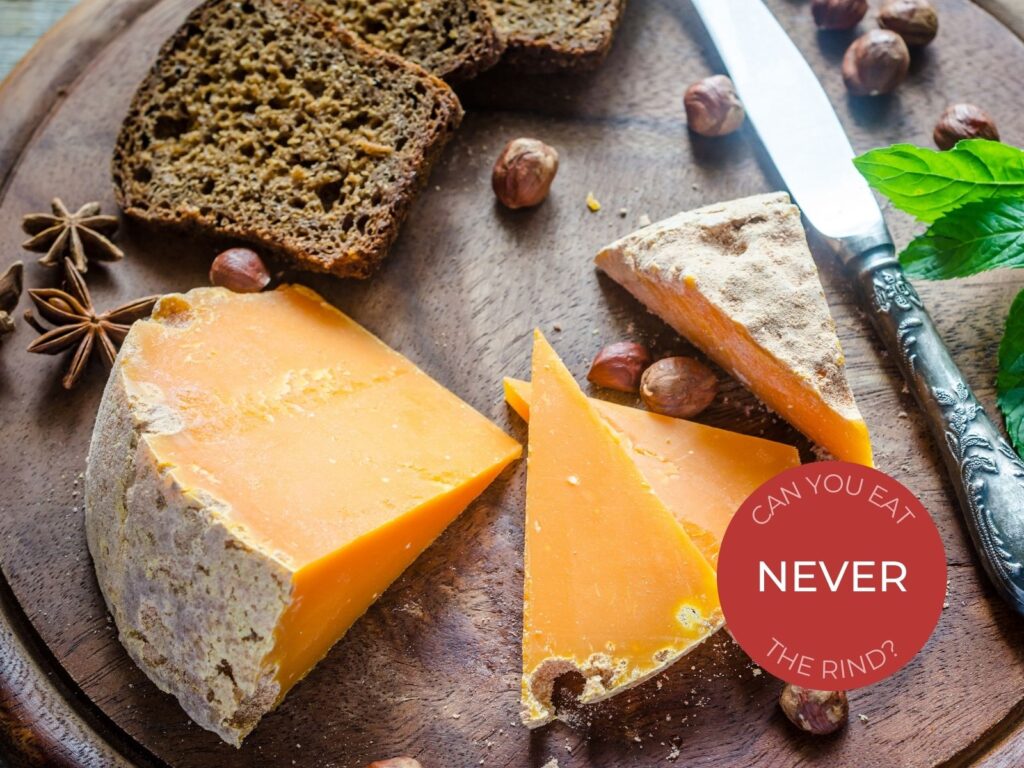
While we are on the topic of inedible rinds, let’s have a look at the most spectacular one of them all, Mimolette! Hailing from northern France, Mimolette is made using an adapted Edam recipe.
During maturation, tiny cheese mites are allowed onto the surface of the cheese to form a rugged, almost moon-like, rind. Of course, you will want to remove this rind before you enjoy the cheese.
You can read more about the spectacular rind on Mimolette cheese in our dedicated post here.
Mont d’Or
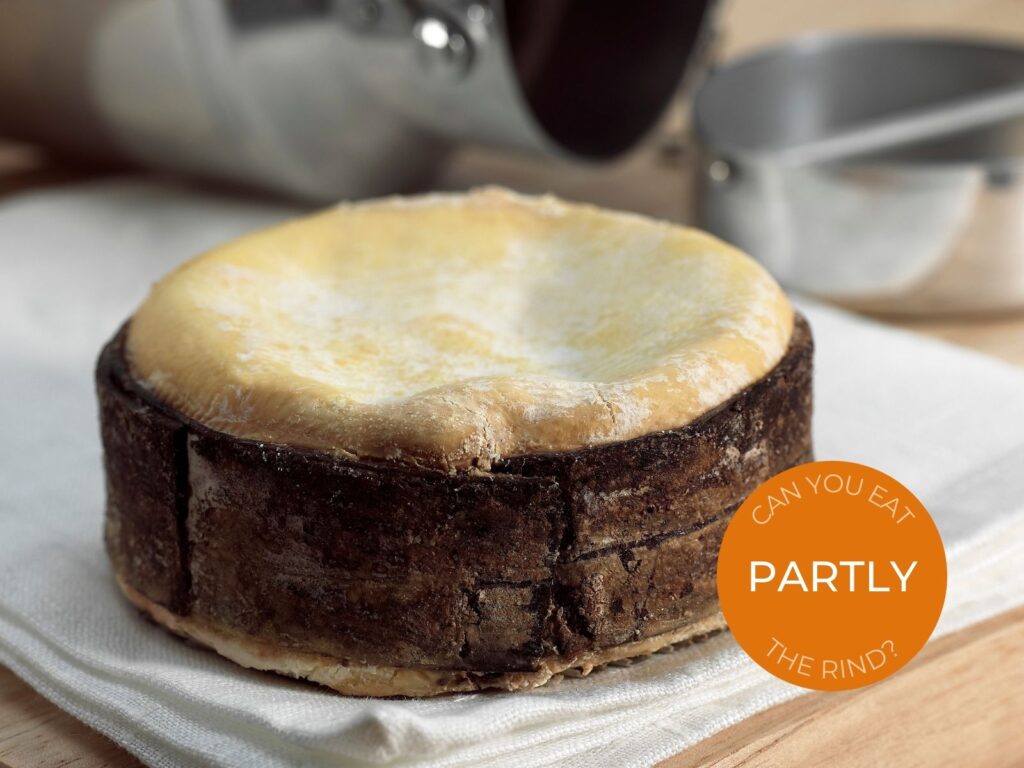
Next, we have the cheese that has been dubbed the Holy Grail of seasonal cheeses. Indeed, Mont d’Or is a soft washed rind cheese from France that finds its way onto most cheese buckets lists around the world.
This iconic raw milk cheese is wrapped in a spruce bark during ageing to keep its contents together and form an eye-catching ripple on its top surface.
We’ve classed Mont d’Or as “Partly” because you obviously cannot eat the spruce bark that is wrapped around it. But you can actually enjoy the natural rind that forms on the cheese. Actually, I would urge you to grab a spoon and scoop a layer of rind with the paste when tasting this cheese.
Ossau-Iraty
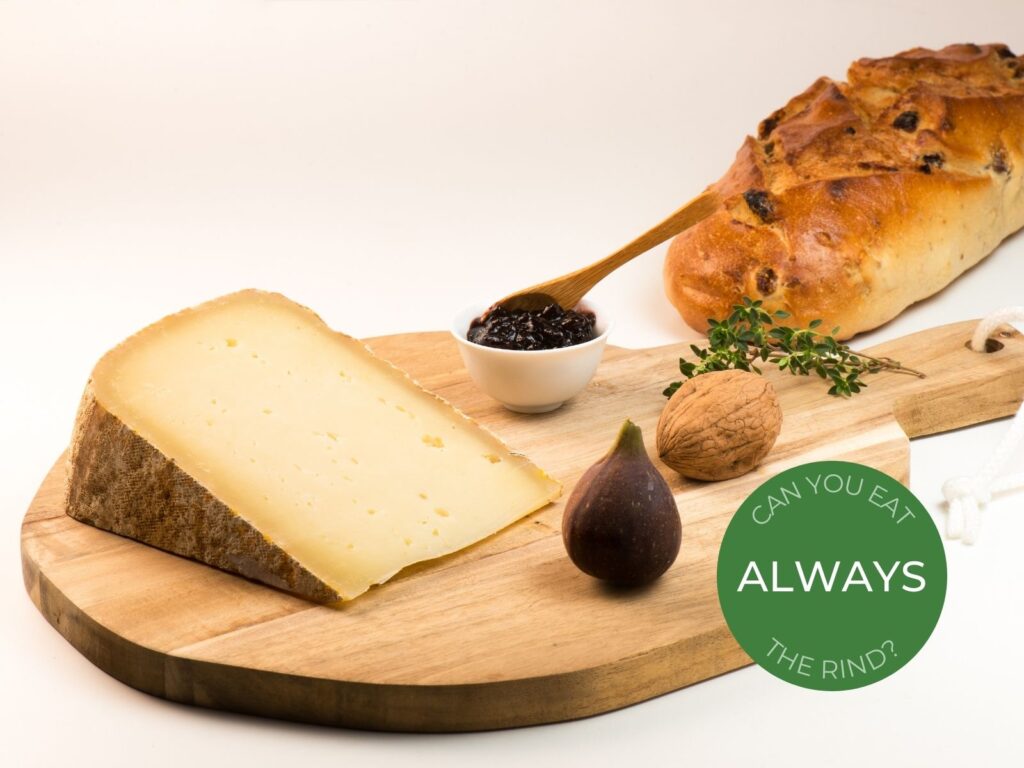
Without a doubt, Ossau-Iraty is one of my favourite French cheeses. This sheep’s milk pressed cheese is produced in the Basque region of France and is a celebration of the local terroir. During maturation, Ossau-Iraty forms a crunchy cream-coloured rind that you absolutely need to try.
In fact, the best way to enjoy this cheese is to cut a piece of cheese (rind and paste) and put it on a piece of bread spread with cherry paste. Heavenly!
Parmigiano Reggiano
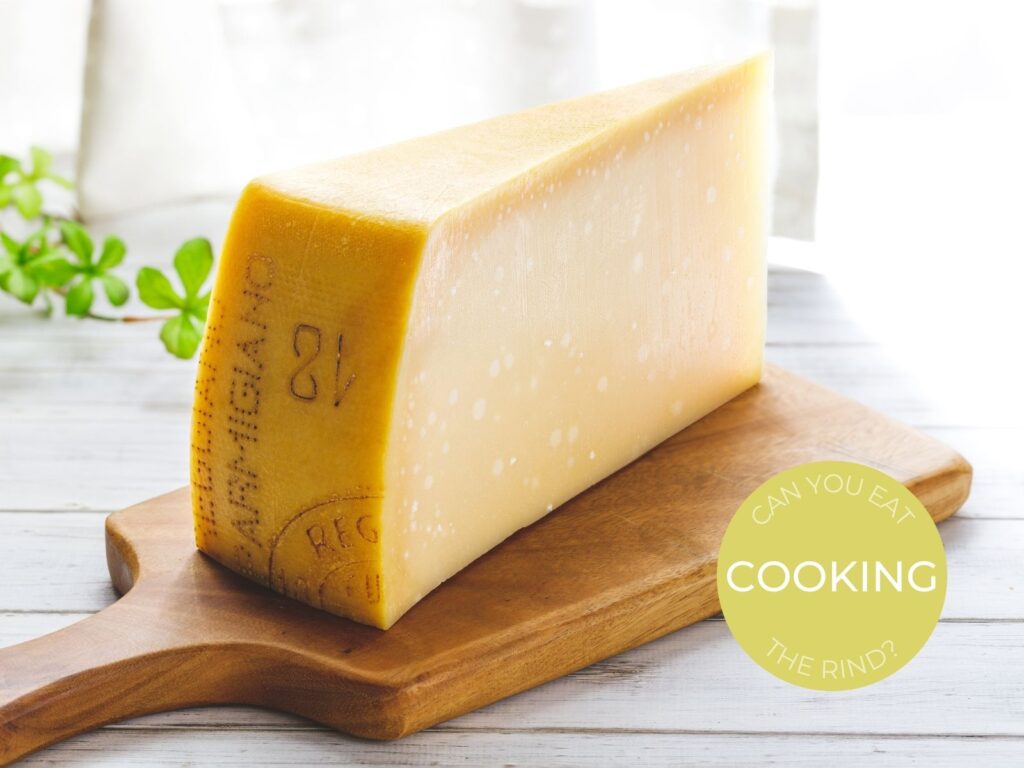
All hail the undisputed King of Italian cheeses! Parmigiano Reggiano is a traditional raw cow’s milk cheese that comes from northern Italy. Just like Grana Padano, it is a grana-style cheese that has a long maturation period (up to 36 months). As a result, it forms a very hard natural rind.
And as was the case for Grana Padano, you do not want to bite into a piece of Reggiano rind. But it is a phenomenal addition to stock and sauces. Actually, you can even deep fry (or air-fry) pieces of Reggiano rind to make a delicious snack.
Pecorino Romano
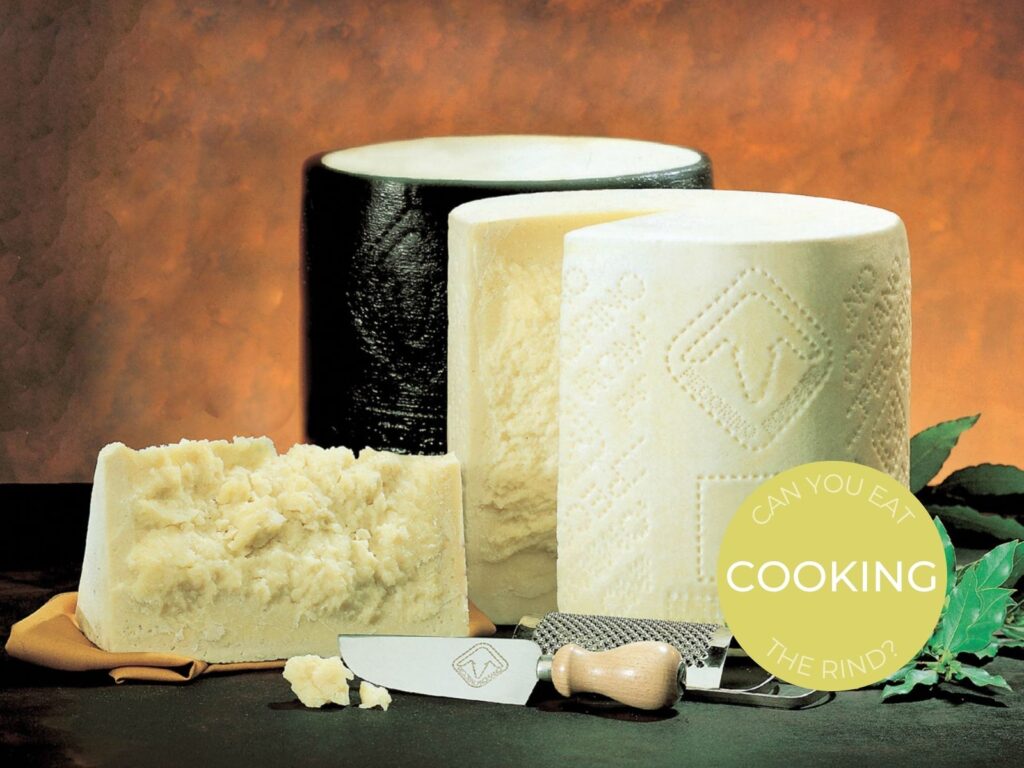
Next, we have another matured Italian cheese, this time made with sheep’s milk. And like Grana Padano and Reggiano, Pecorino Romano has a hard natural rind. Occasionally, the cheese comes wrapped also in a layer of wax.
While Pecorino rind is not as hard as the first two cheeses we mentioned, it is still not very enjoyable to eat. But you can definitely still cook with is in a similar way as Grana Padano and Parmigiano Reggiano.
Rogue River Blue
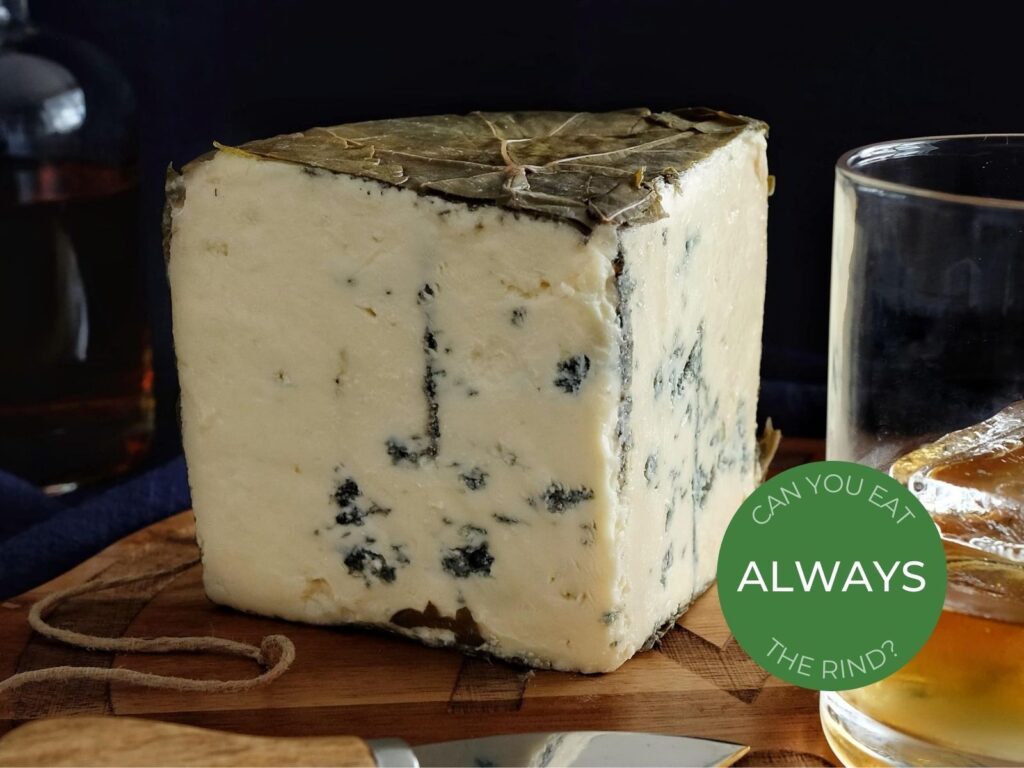
In 2019, Oregon’s Rogue River Blue was crowned the World Champion of Cheese. And this unique American blue cheese is very much worthy of its title. After forming the wheels of cheese, Rogue Creamery coat eat one in Syrah leaves soaked in pear brandy.
As the cheese ages, those flavours diffuse through its paste. While eating grape leaves might seem unusual to some, we strongly urge you to give it a try. You will get an explosion of flavour together with a playful bit of crunch.
Roquefort
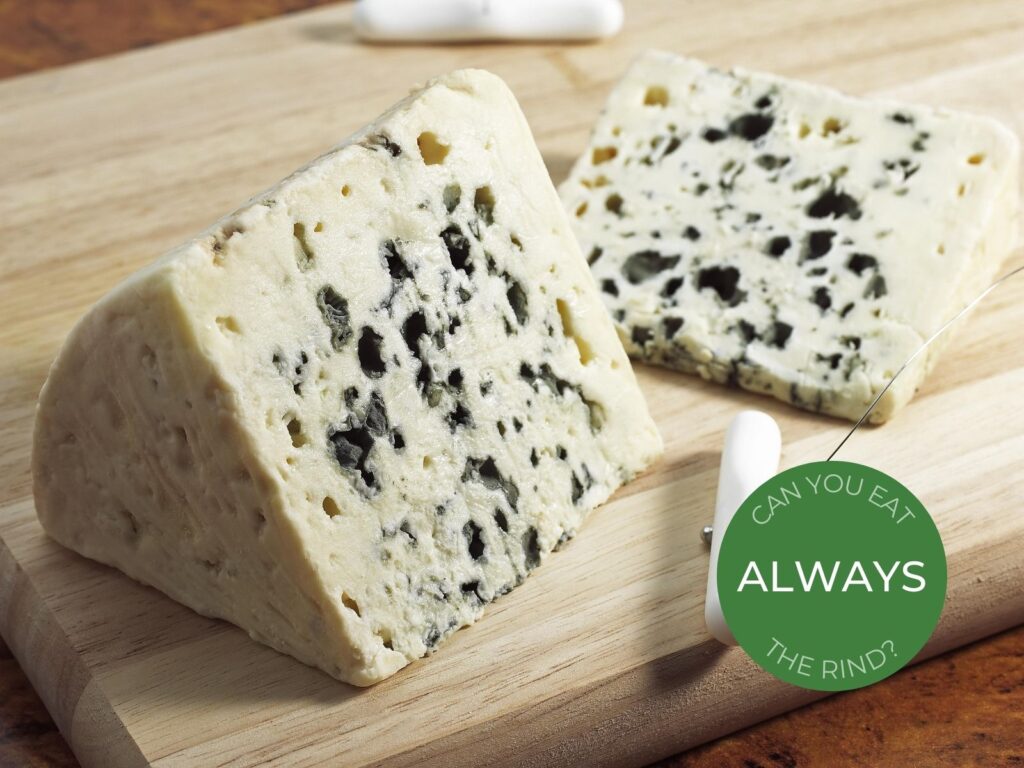
Blue cheeses don’t get much more famous than this iconic raw sheep’s milk cheese from Aveyron, France. As is the case for most blue cheeses, Roquefort forms a delicate natural rind during maturation. But once the cheese is ready for consumption, the affineur cuts it in half and wraps it in foil.
Because of this, most pieces of Roquefort will only have a very thin rind that will look quite similar to the rest of the cheese. Of course, this rind is absolutely safe to consume and it is delicious!
Sainte Maure de Touraine
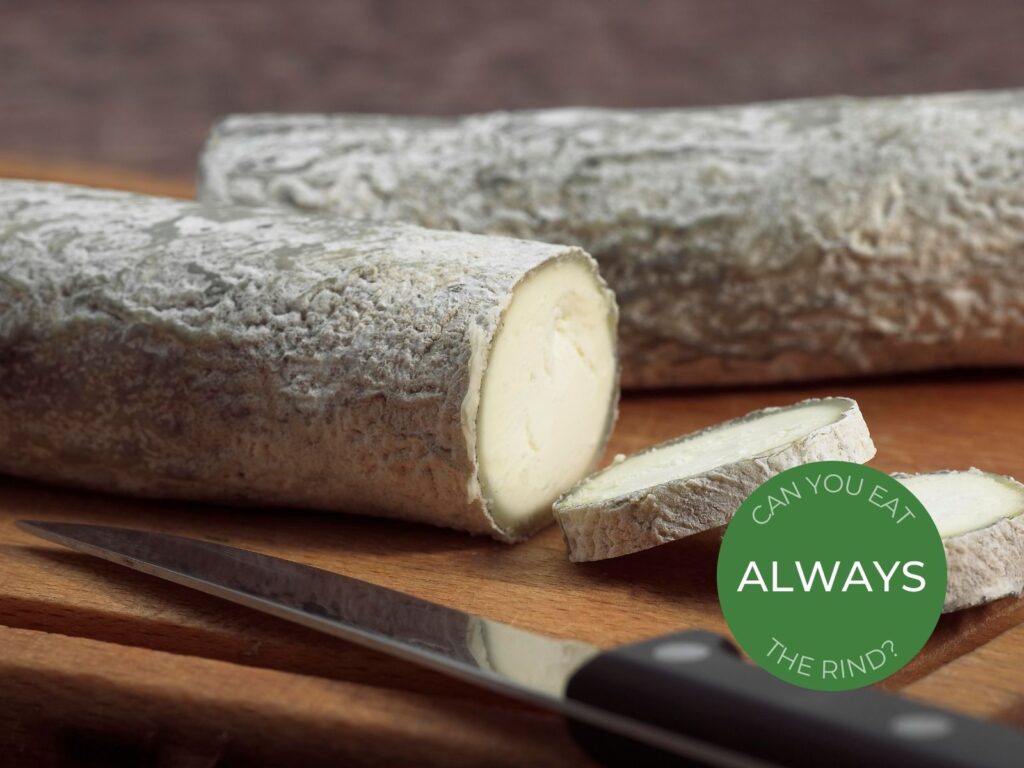
If you’re thinking that this cheese looks different to all the others with edible rinds, you would be right. Indeed, Sainte Maure de Touraine is a goat’s milk log cheese that is dusted in ash before affinage.
The end result is a gorgeous wrinkly log with patches of grey and white. And the rind around it is safe to eat. While the ash plays a major role in the aesthetics of the cheese, it is mostly flavourless.
Sbrinz
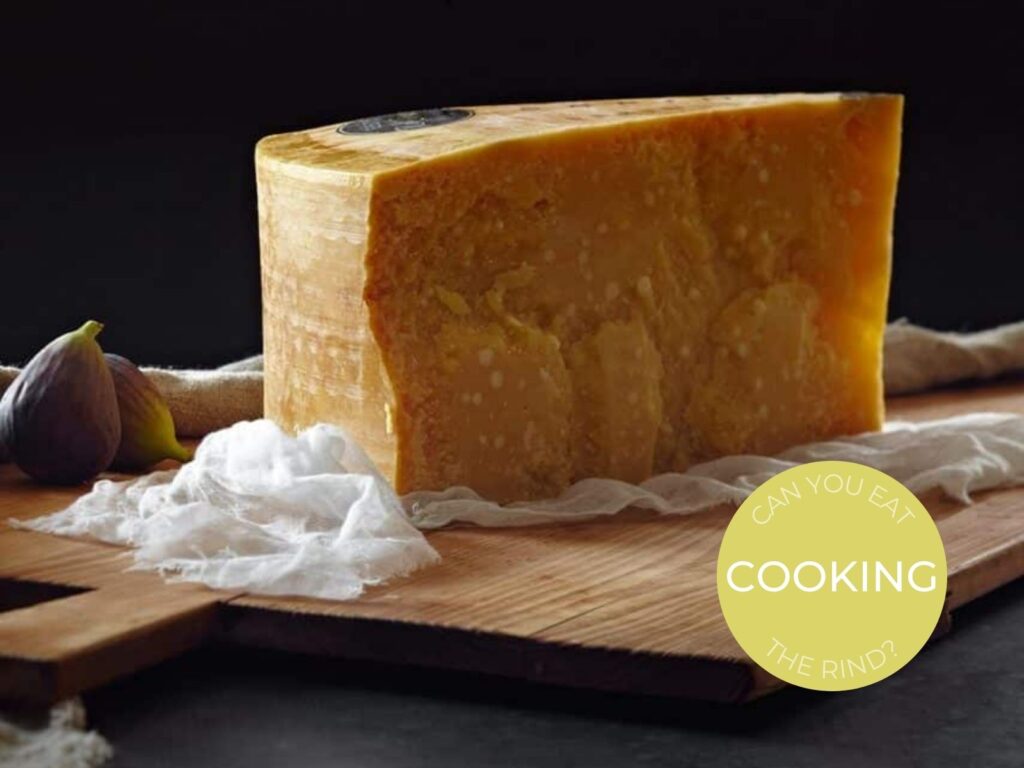
In many ways, Sbrinz is the Swiss take on the Italian grana-style cheeses. This stellar, ultra-hard cow’s milk cheese is aged between 18 to 24 months. Over time, its texture loses moisture and becomes quite hard and crumbly.
And Sbrinz forms a very though natural rind. Unsurprisingly, the rind is too tough to eat raw but makes a great addition to hearty soups and vegetable stock.
Stilton
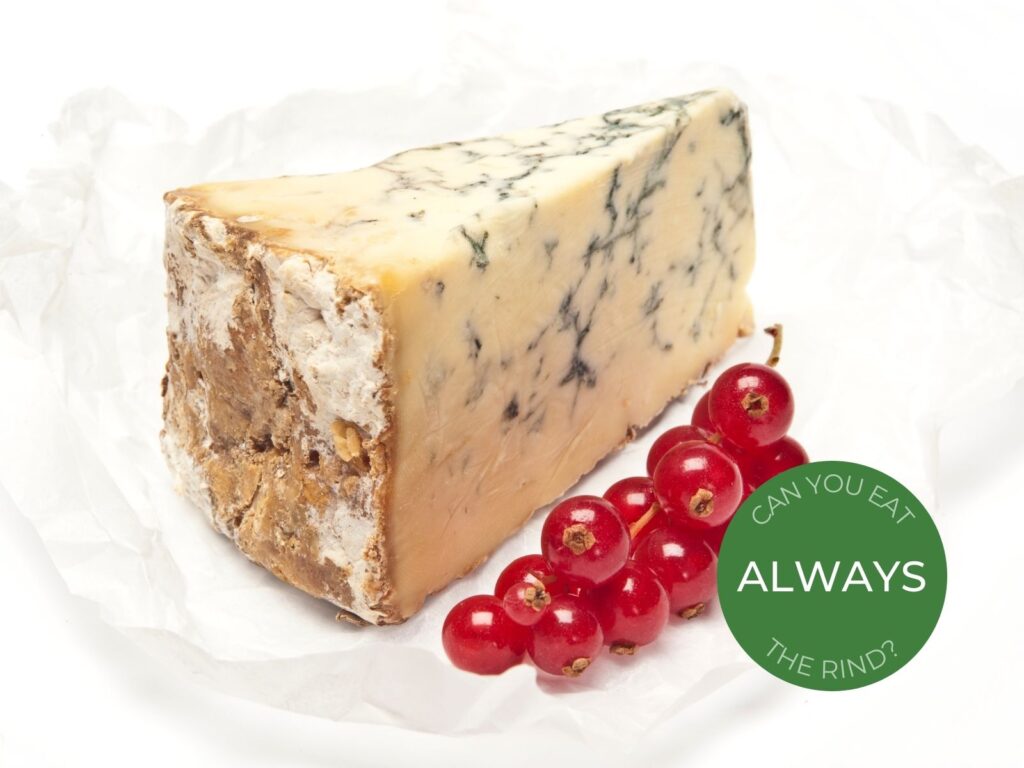
Stilton is one of England’s most famous cheeses. This cow’s milk blue finds its roots in Derbyshire, Leicestershire and Nottinghamshire. And it forms a stunning natural rind during maturation that would put Gorgonzola and Roquefort to shame.
Eating Stilton rind is a quintessential part of the savouring experience. My serving suggestion would be Stilton (paste and rind), green pear and a piece of dark chocolate. And be sure to wash it all down with a glass of fortified wine or dark beer.
Valençay
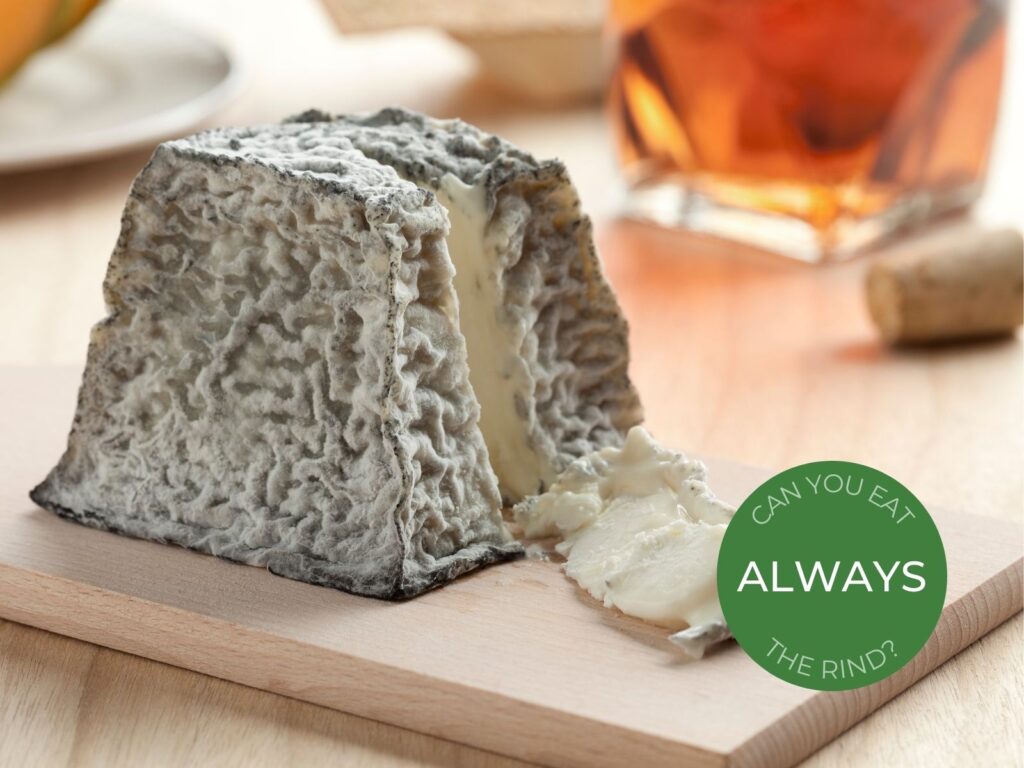
The final cheese we’re looking at is the (almost) pyramid-shaped goat’s cheese from France, Valençay. In a similar manner to Sainte Maure de Touraine, cheesemakers from the Loire region dust the surface of this cheese with vegetable ash before ageing.
And the natural wrinkly rind that forms around the cheese consists largely of Geotrichum candidum. And this edible rind is a must-eat if you want to experience the essence of Valençay in its entirety.
Most cheese rinds are edible
Thank you for reading our comprehensive post on cheese rinds. As you can see, most cheese rinds can (and should) be eaten. And quite a few of the ones which you might not want to eat can still be used in cooking.
Do you agree with our classification of cheese rinds? What’s your favourite rind to eat? Let me know in the comments.

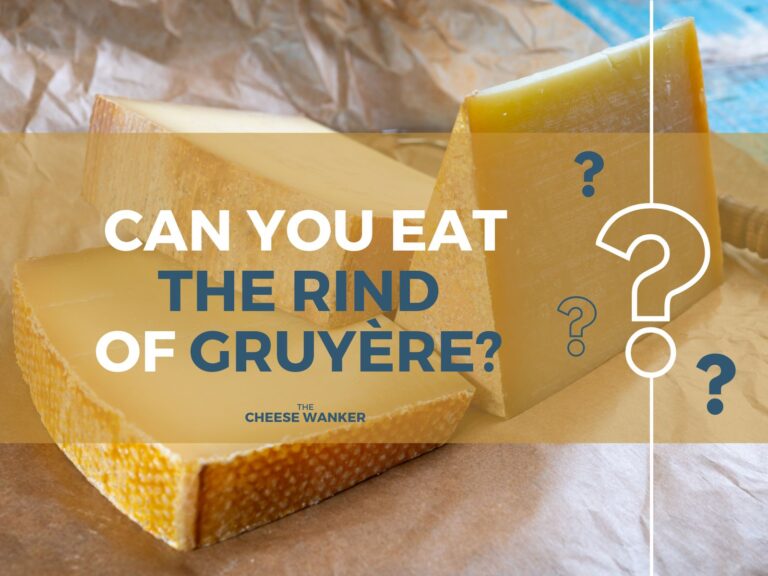
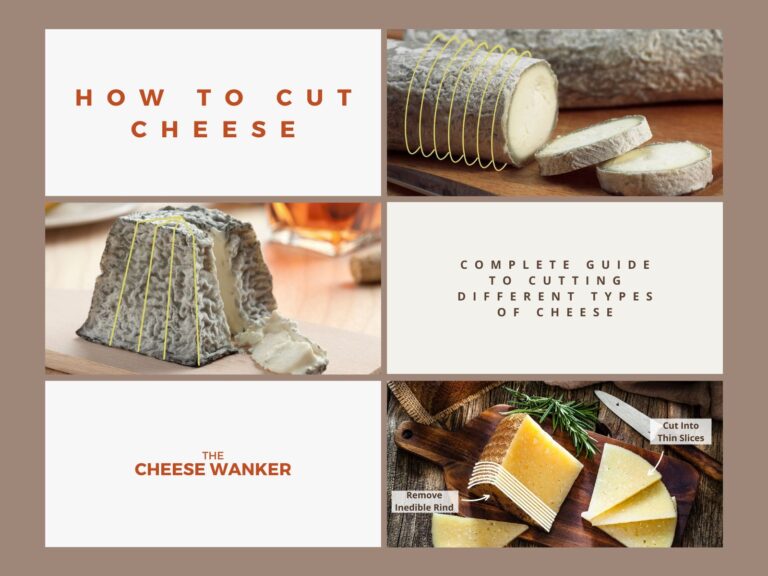
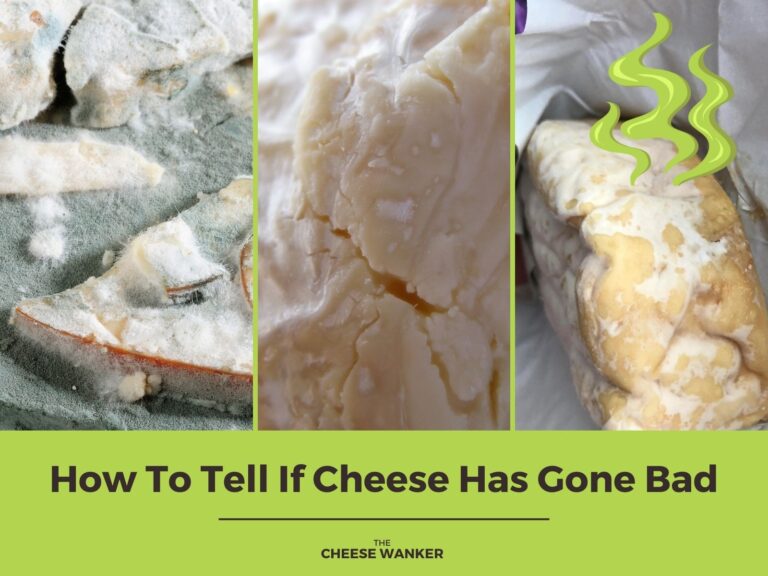
Costco was recently selling Gruyère with large black spots on the rind. Would this rind be safe to eat?
Thank you for reading our post and leaving a comment. If the labelling says Le Gruyère AOP, then the rind is safe (and pleasant) to eat. But, as always, if unsure, you can trim it off. If the cheese has not been wrapped and stored properly, there is the potential for harmful mould growth.